目录
2.1 文件字节流FileInputStream和FileOutputStream
2.2 文件字符流FileReader和FileWriter
3.1 缓冲字节流BufferedInputStream和BufferedOutputStream
3.2 缓冲字符流BufferedReader和BufferedWriter
4.1 数据流DataInputStream和DataOutputStream
4.2 对象流ObjectInputStream和ObjectOutputStream
一、IO流概述
1.1 IO流概述 Input Output Stream
在java程序中,对于数组的输入/输出操作以“流(stream)” 的方式进行;Java提供了各种各样的“流”类,用以获取不同种类的数据;程序中通过标准的方法输入或输出数据。java的流类型一般位于java.io包中。
数据源data source,提供原始数据的原始媒介。常见的:数据库、文件、其他程序、内存、网络连接、IO设备。
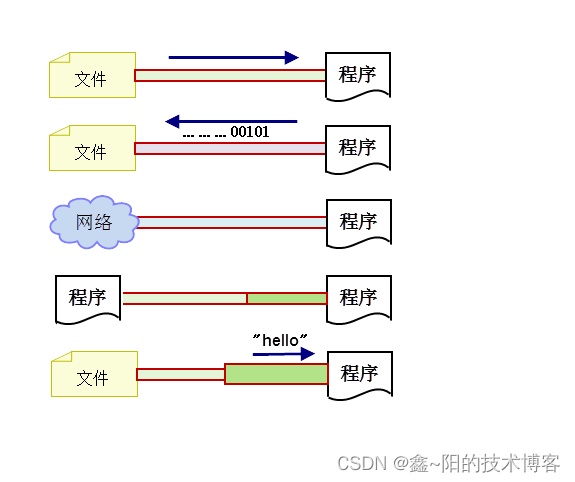
流是一个抽象、动态的概念,是一连串连续动态的数据集合。
数据源就像水箱,流就像水管中流着的水流,程序就是我们最终的用户。流是一个抽象动态的概念,是一连串连续动态的数据集合。
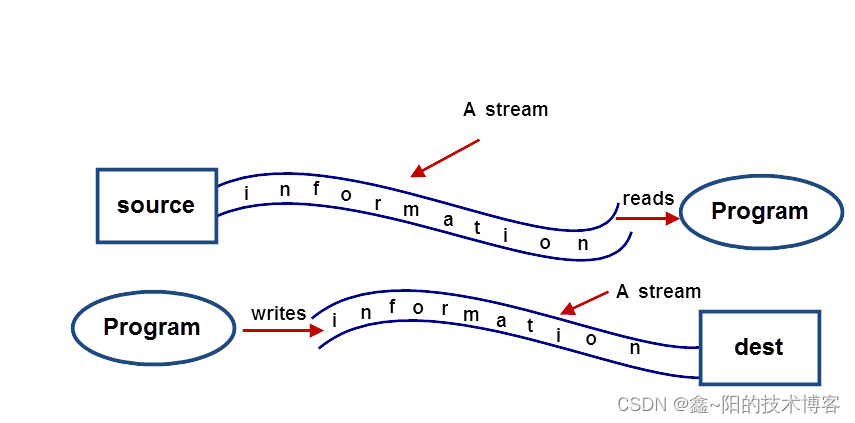
1.2 IO流分类
按流的方向分类:
输入流:数据流向是数据源到程序(以InputStream、Reader结尾的流)。
输出流:数据流向是程序到目的地(以OutputStream、Writer结尾的流)。

注意:
输入/输出流的划分是相对程序而言的,而不是相对数据源。
按处理的数据单元分类:
- 字节流:以字节为单位获取数据,命名上以Stream结尾的流一般是字节流,顶级类InputStream、OutputStream。
- 字符流:以字符为单位获取数据,命名上以Reader/Writer结尾的流一般是字符流,顶级类Reader、Writer。
按处理对象不同分类:
节点流:可以直接从数据源或目的地读写数据,如 FileInputSteam、FileReader等。
处理流:不直接连接到数据源或目的地,是“处理流的流”。通过对其他流的处理提高程序的性能,如BufferedInputStream、BufferedReader等。处理流也叫包装流。
节点流处于IO操作的第一线,所有操作必须通过它们进行;处理流可以对节点流进行包装,提高性能或提高程序的灵活性。
生活案例:节点流就好比水井、水库,处理流就好比自来水厂、水塔等,目的是为了过滤和方便。但是如果没有水井、水库,只有自来水厂和水塔肯定不行。
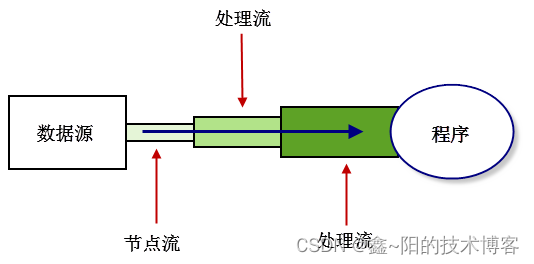
1.3 IO流体系结构
字节流
- InputStream和OutputStream是java语言中最基本的两个字节输入输出流。其他所有字节输入输出流类都继承自这两个基类。
- 这两个类都是抽象类,不能创建他们的实例,只能使用他们的子类
- FilterInputStream和FilterOutputStream是所有包装流的父类
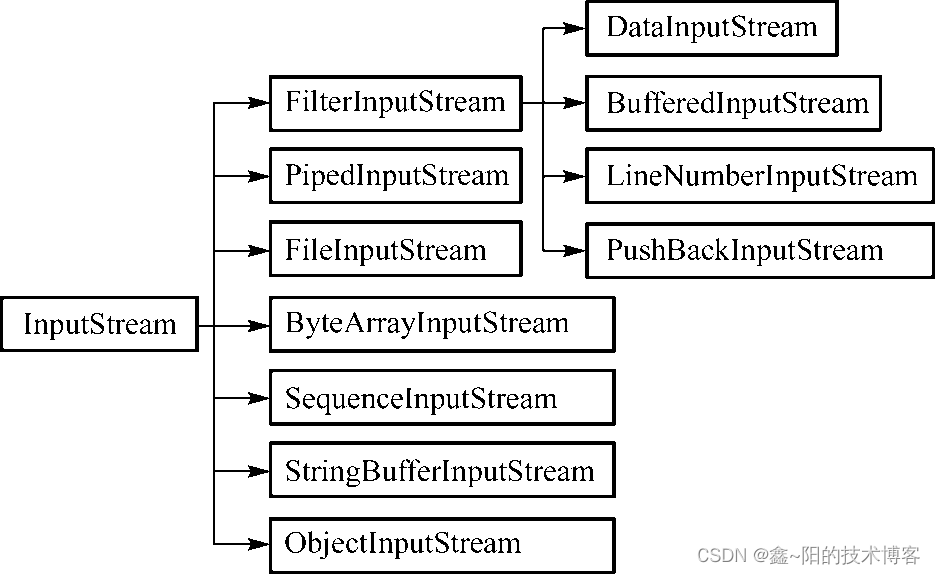
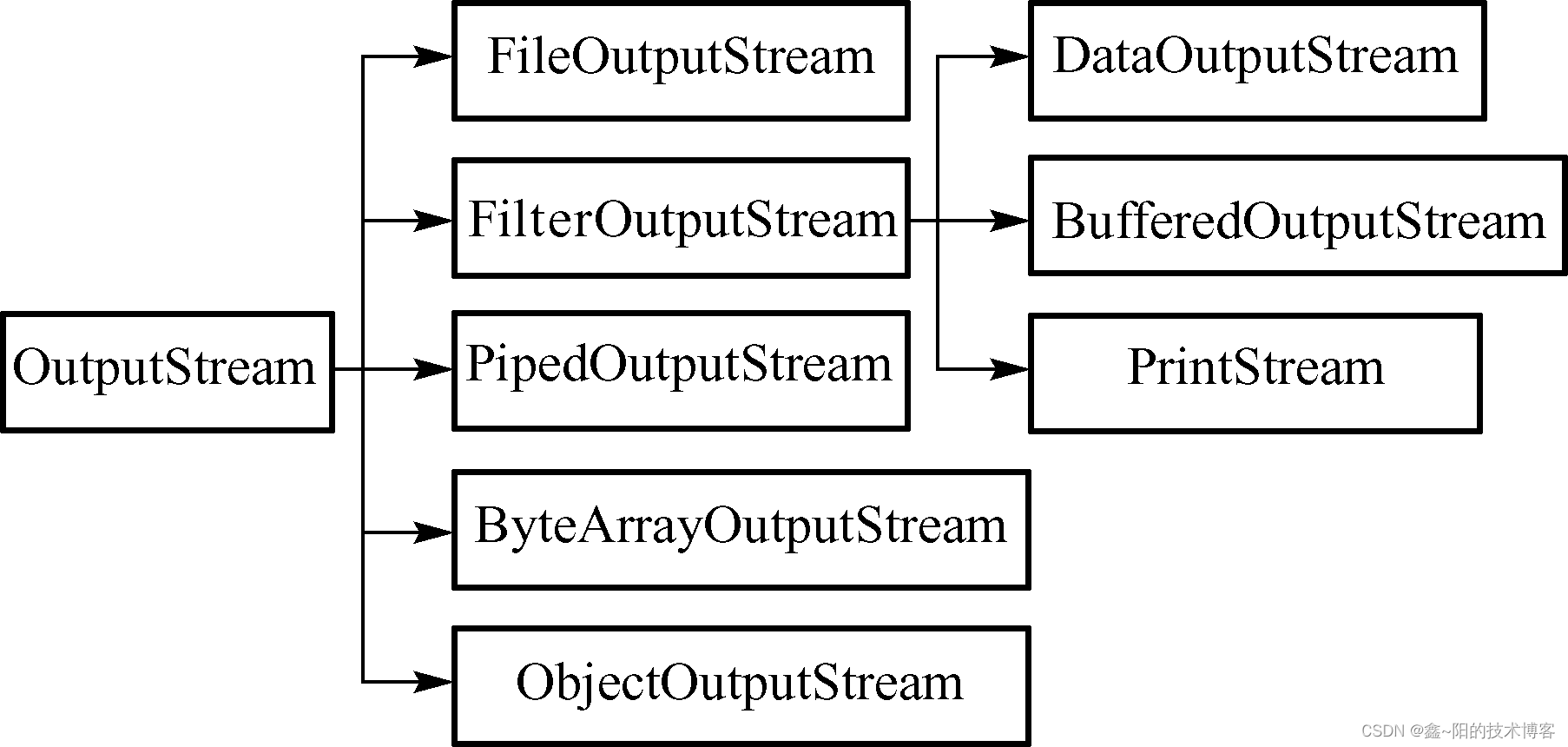
Reader和Writer
- Java语言中两个最基本的两个字符输入输出类。
- 其他所有的字符输入输出流类都继承自这两个基类。
- 这两个类都是抽象类,不能创建他们的实例,只能使用他们的子类
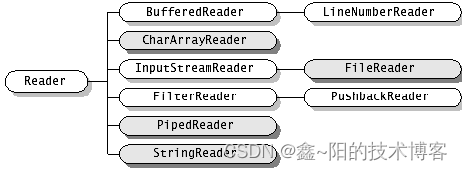
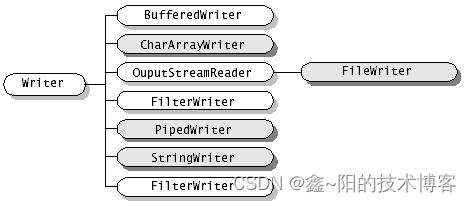
1.4 File类的使用
File类代表文件和文件夹。主要作用有两个:获取文件或者文件夹的属性;实现对文件、文件夹的创建和删除。文件夹:file folder 目录directory
【示例1】使用File获取文件或文件夹属性
public class TestFile1 {
public static void main(String[] args) {
//1.创建一个File对象,指向一个文件或者文件夹
//File file = new File("c:\\bjsxt\\readme.txt");
//File file = new File("c:/bjsxt/readme.txt");
//File file = new File("readme.txt");
File file = new File("c:/");
//2.使用这个File对象,获取文件或者文件夹的属性
System.out.println(file.getName());//文件或者文件夹的名称
System.out.println(file.length());//长度
System.out.println(file.exists());//是否存在
System.out.println(file.getPath());//
System.out.println(file.getAbsolutePath());//绝对路径
System.out.println(file.isDirectory());//判断file是否指向一个目录
System.out.println(file.isFile());//判断file是否指向一个文件
System.out.println(file.isHidden());
System.out.println(file.canWrite());
System.out.println(file.canRead());
System.out.println(file.canExecute());
//String [] fileNameArr = file.list();
//某个文件夹下有哪些子文件夹和文件
System.out.println("============");
File fileArr[] = file.listFiles();
for(File f :fileArr){
//System.out.println(f.toString());
System.out.print(new Date(f.lastModified()).toLocaleString());
if(f.isFile()){
System.out.print(" "+f.length()+" ");
}else{
System.out.print(" <DIR> ");
}
System.out.println(f.getName());
}
}
}
【示例2】使用File类新建、删除文件和文件夹
public class TestFile2 {
public static void main(String[] args) {
//创建一个File对象
//File file = new File("c:/bjsxt/readme.txt");
File file = new File("c:/bjsxt/abc/cba/acb/bac/readme.txt");
//如果文件存在就删除,如果不存在就创建
if(file.exists()){
file.delete();
}else{
try {
//判断所在文件夹是否存在,不存在,要先创建文件夹
File dir = file.getParentFile();
if(!dir.exists()){
//dir.mkdir();//make directory
dir.mkdirs();
}
//创建文件
file.createNewFile();
} catch (IOException e) {
e.printStackTrace();
}
}
}
}
注意:
File不仅可以指向一个文件,也可以指向一个文件夹(作为一个文件对待)
File不能对文件的内容进行操作,需要借助IO流实现
二、文件流
2.1 文件字节流FileInputStream和FileOutputStream
- FileInputStream和FileOutputStream是字节流,是节点流,是数据源,目的地和文件。
- 复制文件需要分别创建一个输入流和输出流完成文件读写
- 需要创建一个中转站,借助循环和中转站完成复制。
- 流使用完一定要关闭,这和垃圾回收没有关系
【示例3】复制文件(中转站是一个字节)
public class TestFileStream {
public static void main(String[] args) throws IOException {
//1.创建流
File file1 = new File("e:/readme.txt");
File file2 = new File("e:/readme2.txt");
InputStream fis = new FileInputStream(file1);
OutputStream fos = new FileOutputStream(file2);
//2.使用流
//2.1 准备一个中转站(一个字节)
int n;
//2.2 读取一个字节到中转站
n = fis.read();
while(n!=-1){//读到了文件的末尾
//2.3 写一个字节到目的文件
fos.write(n);
//2.4 再读一个
n = fis.read();
}
//3.关闭流
fis.close();
fos.close();
}
}
缺点:中转站太小,速度慢,效率低;复制更大的文件效果更明显;可以将中转站由一个字节变为一个字节数组,减少读写硬盘的次数。
问题:如何不是覆盖文件,而是追加内容,如何实现。
【示例4】复制文件(中转站是一个字节数组)
public class TestFileStream2 {
public static void main(String[] args) throws IOException {
//1.创建流
// File file1 = new File("e:/readme.txt");
// File file2 = new File("e:/readme2.txt");
// InputStream fis = new FileInputStream(file1);
// //OutputStream fos = new FileOutputStream(file2);//默认是覆盖文件
// OutputStream fos = new FileOutputStream(file2,true);//这是追加内容
// InputStream fis = new FileInputStream(new File("e:/readme.txt"));
// OutputStream fos = new FileOutputStream(new File("e:/readme2.txt"),true);
InputStream fis = new FileInputStream("e:/readme.txt");
OutputStream fos = new FileOutputStream("e:/readme2.txt",true);
//2.使用流
//2.1 准备一个中转站(一个字节数组)
byte [] buf = new byte[1024];
//2.2 读取一些字节到中转站
int len = fis.read(buf);//读取文件的数据到buf数组,返回真实读取的字节个数赋给len
while(len!=-1){//读到了文件的末尾
//2.3 写一个字节字节数组到目的文件
//fos.write(buf);
fos.write(buf,0,len);
//2.4 再读一些字节到字节数组
len = fis.read(buf);
}
//3.关闭流
fis.close();
fos.close();
}
}
【示例5】进行异常处理
public class TestFileStream3 {
public static void main(String[] args) {
InputStream fis = null;
OutputStream fos = null;
try{
//1.创建流
fis = new FileInputStream("e:/readme.txt");
fos = new FileOutputStream("e:/readme2.txt");
//2.使用流
//2.1 准备一个中转站(一个字节数组)
byte [] buf = new byte[1024];
//2.2 读取一些字节到中转站
int len = fis.read(buf);
while(len!=-1){//读到了文件的末尾
//2.3 写一个字节字节数组到目的文件
//fos.write(buf);
fos.write(buf,0,len);
//2.4 再读一些字节到字节数组
len = fis.read(buf);
}
}catch (FileNotFoundException e){
e.printStackTrace();
} catch (IOException e) {
e.printStackTrace();
} finally {
//3.关闭流
try {
if(fis!= null){
fis.close();
}
} catch (IOException e) {
e.printStackTrace();
}
try {
if(fos!= null){
fos.close();
}
} catch (IOException e) {
e.printStackTrace();
}
}
}
}
- 异常处理的分析:创建流、使用流要使用一次try-catch语句,关闭流要分开进行异常处理
- Java7异常处理新特征:try-with-resources:不用显示的进行资源的关闭,只要将资源的实例化对象放入try后面的()中,作用范围是当前try语句,执行完毕(正常完成或是发生意外)后就会自动进行关闭,可省略finally语句,更加简单实用。
【示例6】JDK7异常处理新特征
public class TestFileStream4 {
public static void main(String[] args) {
try(InputStream fis = new FileInputStream("e:/readme.txt");
OutputStream fos = new FileOutputStream("e:/readme2.txt")){
//1.创建流
//2.使用流
//2.1 准备一个中转站(一个字节数组)
byte [] buf = new byte[1024];
//2.2 读取一些字节到中转站
int len = fis.read(buf);
while(len!=-1){//读到了文件的末尾
//2.3 写一个字节字节数组到目的文件
//fos.write(buf);
fos.write(buf,0,len);
//2.4 再读一些字节到字节数组
len = fis.read(buf);
}
}catch (FileNotFoundException e){
e.printStackTrace();
} catch (IOException e) {
e.printStackTrace();
}
}
}
- 关于Java9中异常处理的新变化:try 之前定义好对象,try () 括号中引入创建好的对象。如果多个对象,使用;分隔。如果try之前定义的对象会抛出异常,就不推荐使用该方式,因为需要在方法签名中throws异常。
【示例7】JDK9异常处理新特征
public class TestFileStream5 {
public static void main(String[] args) throws IOException {
//1.创建流
InputStream fis = new FileInputStream("e:/readme.txt");;
OutputStream fos = new FileOutputStream("e:/readme2.txt");
try(fis;fos){
//2.使用流
//2.1 准备一个中转站(一个字节数组)
byte [] buf = new byte[1024];
//2.2 读取一些字节到中转站
int len = fis.read(buf);
while(len!=-1){//读到了文件的末尾
//2.3 写一个字节字节数组到目的文件
//fos.write(buf);
fos.write(buf,0,len);
//2.4 再读一些字节到字节数组
len = fis.read(buf);
}
}catch (FileNotFoundException e){
e.printStackTrace();
} catch (IOException e) {
e.printStackTrace();
}
}
}
2.2 文件字符流FileReader和FileWriter
FileReader和FileWriter是字符流,节点流,数据源和目的地是文件。
【示例8】复制文件(中转站是一个字符)
public class TestFileReaderWriter {
public static void main(String[] args) throws IOException {
//1.创建字符流
Reader fr = new FileReader(new File("e:/readme.txt"));
Writer fw = new FileWriter("e:/readme2.txt");
//2.使用字符流
/*
int n = fr.read();//一次读一个字符,不是一个字节。一个汉字一次搞定
while(n!= -1){
//System.out.println((char)n);
fw.write(n);
n = fr.read();
}
*/
int n=0;
while((n = fr.read())!=-1){
fw.write(n);
}
//3.关闭字符流
fr.close();
fw.close();
}
}
【示例9】复制文件(中转站是一个字符数组,并进行异常处理)
public class TestFileReaderWriter2 {
public static void main(String[] args) {
//1.创建字符流
try( Reader fr = new FileReader(new File("e:/readme.txt"));
Writer fw = new FileWriter("e:/readm22.txt");){
//2.使用字符流
char
int len = fr.read(cbuf);
while(len!= -1){
//System.out.println(cbuf);
fw.write(cbuf,0,len);
len = fr.read(cbuf);
}
}catch (FileNotFoundException e) {
e.printStackTrace();
} catch (IOException e) {
e.printStackTrace();
}
}
}
其实只有字节流,没有字符流,字符流的底层还是字节流,进行了封装转换,是开发者可以更简单的来处理非英文字符
字节流可以完成所有类型文件的复制(文本、音频、视频、图片、chm);字符流只可以完成文本文件的复制(txt、java) doc不是文本文件;字符流一般用来处理包含中文的文本文件。
三、缓冲流
3.1 缓冲字节流BufferedInputStream和BufferedOutputStream
【示例10】复制文件(使用缓冲流字节流提高效率)
public class TestCopy5 {
public static void main(String[] args) throws IOException {
//1.创建一个输入流和输出流
InputStream fis = new FileInputStream(new File("e:/JDK_API.CHM"));
OutputStream fos = new FileOutputStream(new File("e:/JDK_API2.CHM"));
//默认输入缓冲区大小8192
BufferedInputStream bis = new BufferedInputStream(fis);
//默认输出缓冲区大小8192
BufferedOutputStream bos = new BufferedOutputStream(fos);
//2.使用输入流和输出流完成文件复制
//2.1准备一个中转站(水杯)
int n;
//2.2先读一个字节
n = bis.read();//读取一个字节,赋给n
while(n != -1){
//2.3再写一个字节
bos.write(n);
//2.4在读一个字节
n = bis.read();
}
//3.关闭输入流和输出流
bis.close();
bos.close();
}
}
缓冲流的原理

只要关闭高层流即可,底层流不用手动关闭;因为高层的关闭方法就是把底层流关闭
如何刷新输出缓冲区(让缓冲区内容写入硬盘,保证一致)
- 满了就自动刷新
- bos.close()先flush,再关闭
- 手动刷新flush()
3.2 缓冲字符流BufferedReader和BufferedWriter
问题:之前的文件读写都是按照字节、字符或者数组来实现的,对于文本文件而言,能否按照行,一行行读写呢?
提供了BufferedReader和BufferedWriter实现按行读写
【示例11】复制文件(按行读写)
public class TestCopy6 {
public static void main(String[] args) throws IOException {
//创建两个流
BufferedReader br =
new BufferedReader(new FileReader(new File("e:/sqlnet.log")));
BufferedWriter bw =
new BufferedWriter(new FileWriter("e:/sqlnet2.log"));
//使用两个流完成按行读取的功能
//中转站就是一个字符串,存储一行数据
//先读一行
String str = br.readLine();
while(str != null ){
//再写一行
bw.write(str);
bw.newLine(); //bw.write("\r\n");不同操作系统中换行符是不同的
//再读一行
str = br.readLine();//!!!
}
//关闭两个流
br.close();
bw.close();
}
}
总结1:BufferedReader和BufferedWriter的优点
1.速度快
2.简化编程
总结2:readLine()底层原理
底层还是一个一个字符的读取,append()放入到StringBuilder(或者char[])中,遇到换行符,将StringBuider(char[]) 转换成String并返回
总结3:不同的操作系统中换行符是不同的
Unix系统里,每行结尾只有“<换行>”,即“\n”;
Windows系统里面,每行结尾是“<回车><换行>”,即“\r\n”;
Mac系统里,每行结尾是“<回车>”,即“\r”。
四、数据流和对象流
4.1 数据流DataInputStream和DataOutputStream
之前使用文件流、缓冲流读取文件只能按照字节、数组方式读取,最方便的也是按行读取,能否很方便的实现对各种基本类型和引用数据类型的读写,并保留其本身的类型。数据流DataInputStream和DataOutputStream和对象流ObjectInputStream和ObjectOutputStream可以解决这个问题,最大的优势就是提供了方便操作各种数据类型的方法,直接调用,简单方便。
注意:
- 只有字节流,没有字符流
- 都是处理流,不是节点流
- 数据流只能操作基本数据类型和字符串,对象流还可以操作对象
- 写入的是二进制数据,无法直接通过记事本等查看
- 写入的数据需要使用对应的输入流来读取
【示例12】使用数据流读写文件
public class TestDataStream {
public static void main(String[] args) throws Exception {
//write();
read();
}
public static void write() throws Exception{
//创建输出流
OutputStream fos = new FileOutputStream("e:/readme2.txt");
BufferedOutputStream bos = new BufferedOutputStream(fos);
DataOutputStream dos = new DataOutputStream(bos);
//使用输出流
dos.writeInt(123);
dos.writeDouble(3.14);
dos.writeChar('A');
dos.writeBoolean(true);
dos.writeUTF("bjsxt");
//关闭输出流
dos.close();
}
public static void read() throws Exception{
//创建输入流
DataInputStream dis =
new DataInputStream(new BufferedInputStream(
new FileInputStream(
new File("e:/readme2.txt"))));
//使用输入流
System.out.println(dis.readInt());
double d = dis.readDouble();
System.out.println(d);
System.out.println(dis.readChar());
System.out.println(dis.readBoolean());
System.out.println(dis.readUTF());
//System.out.println(dis.readUTF());
//关闭输入流
dis.close();
}
}
4.2 对象流ObjectInputStream和ObjectOutputStream
【示例13】使用对象流读写文件
public class TestObjectStream {
public static void main(String[] args) throws Exception {
//write();
read();
}
public static void write() throws Exception{
//创建输出流
OutputStream fos = new FileOutputStream("e:/readme2.txt");
BufferedOutputStream bos = new BufferedOutputStream(fos);
ObjectOutputStream oos = new ObjectOutputStream(bos);
//使用输出流
oos.writeInt(123);
oos.writeDouble(3.14);
oos.writeChar('A');
oos.writeBoolean(true);
oos.writeUTF("bjsxt");
oos.writeObject(new Date());
oos.writeObject(new Student(1, "111", 22, 333.3));
//关闭输出流
oos.close();
}
public static void read() throws Exception{
//创建输入流
ObjectInputStream ois =
new ObjectInputStream(new BufferedInputStream(
new FileInputStream(
new File("e:/readme2.txt"))));
//使用输入流
System.out.println(ois.readInt());
double d = ois.readDouble();
System.out.println(d);
System.out.println(ois.readChar());
System.out.println(ois.readBoolean());
System.out.println(ois.readUTF());
//System.out.println(dis.readUTF());
Object date = (Date)ois.readObject();
System.out.println(date);
System.out.println(ois.readObject());
//关闭输入流
ois.close();
}
}
注意:使用对象流读写引用类型的数据,需要相应类实现Serializable接口,否则会提示异常,提示没有序列化,比如:java.io.NotSerializableException: com.bjsxt.entity.Student。
4.3 序列化和反序列化
1. 什么是序列化和反序列化
序列化:Serialization 将对象的状态信息转换为可以存储或传输的形式的过程。
对象(内存)-------->字节数组 字节序列(外存、网络)
内存-----》硬盘 序列化
硬盘-----》内存 反序列化
反序列化:DeSerialization
字节数组 字节序列(外存、网络)----------------->对象
2.什么时候需要序列化和反序列化
存储和传输 比如存储到外存(硬盘)中 传输到网络
3.如何实现序列化和反序列化
相应的类要实现Serializable接口
public class Student implements Serializable {
}
ObjectOutputStream oos = new ObjectOutputStream(bos);
oos.writeObject(new Student(1, "111", 22, 333.3));
ObjectInputStream ois = new ObjectInputStream(bis);
Student stu = (Student)ois.readObject();
4.序列化的细节
- 为什么序列化接口没有任何方法,那还有什么用
- (查看ObjectOutputStream源码)
- static属性不参与序列化
- 如果不希望某个属性参与序列化,要使用transient修饰
- Exception in thread "main" java.io.InvalidClassException:
- com.bjsxt.entity.Student; local class incompatible:
- stream classdesc serialVersionUID = 5954363181006202290,
- local class serialVersionUID = -1877375566195009060
- 解决方案:给出一个固定的序列化版本号
- 使用对象流把一个对象写到文件时不仅保证该对象是序列化的,而且该对象的成员对象也必须是可序列化的。
- https://jingyan.baidu.com/article/656db918c36534e381249c83.html
五、其他流
5.1 其他流
1. 打印流:PrintStream 和PrintWriter
只有输出流, 没有输入流
System.out、System.err是PrintStream的实例变量
2.转换流:InputStreamReader和OutputStreamWriter
实现字节流到字符流的转换,是适配器设计模式的应用
只能从字节流转换成字符流,可以带来处理字符的便利。没有字符流转换成字节流的转换流,因为没有这种需求。
3.字节数组流ByteArrayInputStream和ByteArrayOutputStream
是节点流,数据源是字节数组,可以实现各种基本和引用数据类型与字节数组之间的相互转换
4.Java IO流的设计使用了装饰模式,动态组装流,可以减少子类的数量,是继承的一种替代方案
OutputStream fos = new FileOutputStream("e:/readme.txt");
//提高速度
BufferedOutputStream bos = new BufferedOutputStream(fos);
//简化操作
DataOutputStream dos = new DataOutputStream(bos);
【示例14】认识其他IO流
public class Test {
public static void main(String[] args) throws IOException {
//1.打印流 只有输出流,没有输入流
PrintStream ps; //字节流 System.out System.err
PrintWriter pw; //字符流 后面讲解Servlet时会使用
//System.out就是PrintStream的一个引用变量
System.out.println();
//System.err也是PrintStream的一个引用变量
System.err.println();
//println()强大作用:不管什么类型数据,都给你变成字符串,并输出
//2.转换流
//接收键盘的输入一行数据,并输出
//接收一行数据,需要使用BufferedReader(或者Scanner)。接收键盘的输入,
//需要使用System.in;@2
// InputStream is = System.in; //三相插头
//将字节输入流InputStream转换为字符输入流Reader 三相转两相的转换头
// Reader reader = new InputStreamReader(is);
// BufferedReader br = new BufferedReader(reader);//两相的插座
BufferedReader br = new BufferedReader(new InputStreamReader(System.in));
BufferedWriter bw = new BufferedWriter(new FileWriter("e:/bjsxt.txt"));
//使用两个流完成按行读取的功能
//中转站就是一个字符串,存储一行数据
//先读一行
String str = br.readLine();
while(!"bye".equals(str) ){
//再写一行
bw.write(str);
//bw.write("\r\n");不同操作系统中换行符是不同的
bw.newLine();
//再读一行
str = br.readLine();//!!!
}
//关闭两个流
br.close();
bw.close();
FileInputStream fis; //节点流 数据源是文件
FileOutputStream fos;//节点流 目的地是文件
//数组流 节点流 数据源和目的地都是数组
ByteArrayInputStream bais;
ByteArrayOutputStream baos;
}
}

5.2 复制文件夹
问题1:使用字节流还是字符流
使用字节流 可能有图片、视频、音频......等二进制文件
问题2:如何提高复制速度
BufferedInputStream和BufferedOutputStream
byte [] buf = new byte[1024];
问题3:涉及的技能点
1. IO流:文件的复制
2. 递归:各级文件夹和文件的递归复制
3. File类:文件夹的定义和创建
问题4:问题的迭代
1.复制一个文件
2.复制一个文件夹下所有的文件(不包括子文件夹)
3.复制一个文件夹下所有的文件和子文件夹,从而完成文件夹的复制
【示例15】复制一个文件
public class TestDirCopy {
public static void main(String[] args) {
copyFile("e:/readme.txt","d:/readme2.txt");
}
public static void copyFile(String sourceFileName,String targetFileName) {
//1.创建一个输入流和输出流
BufferedInputStream bis = null;
BufferedOutputStream bos = null;
try {
bis = new BufferedInputStream(new FileInputStream(new File(sourceFileName)));
bos = new BufferedOutputStream(new FileOutputStream(targetFileName));
//2.使用输入流和输出流完成文件复制
//2.1准备一个中转站(水杯)
byte [] buf = new byte[1024];
int len = bis.read(buf);
while(len !=-1){
bos.write(buf, 0, len);
len = bis.read(buf);
}
} catch (FileNotFoundException e) {
e.printStackTrace();
} catch (IOException e) {
e.printStackTrace();
}finally{
//3.关闭输入流和输出流
try {
if(bis != null){
bis.close();
}
} catch (IOException e) {
e.printStackTrace();
}
try {
if(bos != null){
bos.close();
}
} catch (IOException e) {
e.printStackTrace();
}
}
}
}
【示例16】复制一个文件文件夹(含子文件夹)
public class TestDirCopy3 {
public static void main(String[] args) {
//copyFile("e:/readme.txt","d:/readme2.txt");
copyDir("e:/402视频","e:/zzz视频");
}
public static void copyDir(String sourceDirName,String targetDirName){
//创建一个目的文件夹
//File dir = new File("e:/403");
File targetDir = new File(targetDirName);
if(!targetDir.exists()){
targetDir.mkdir();
}
//复制源文件夹下的所有文件到目的文件夹
File sourceDir = new File(sourceDirName);
File [] files = sourceDir.listFiles();//文件夹下所有的文件和子文件夹
for(File file:files){
//如果是文件就复制
if(file.isFile()){
//copyFile("e:/402/402授课笔记.nyf","e:/zzz/402授课笔记.nyf");
copyFile(sourceDirName+"/"+file.getName(),targetDirName+"/"+file.getName());
}
//如果是文件夹,就递归
if(file.isDirectory()){
//copyDir("e:/402/20180226-常用类","e:/zzz/20180226-常用类");
copyDir(sourceDirName+"/"+file.getName(),targetDirName+"/"+file.getName());
}
}
}
}






















 183
183











 被折叠的 条评论
为什么被折叠?
被折叠的 条评论
为什么被折叠?








